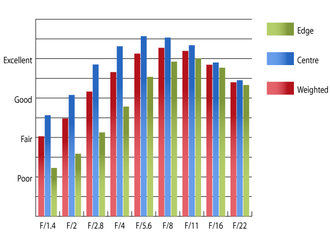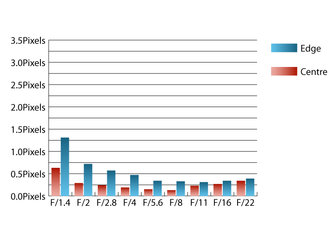Samyang 85mm f/1.4 AS IF UMC Lens Review
Samyang 85mm f/1.4 AS IF UMC Performance
Samyang describe this lens as a 'Portrait lens', which may explain some of the characteristics of its optical performance. At f/1.4 sharpness in the centre of the frame is only fairly good, and towards the edges, 'dreamy' would be a good way of describing the clarity here. This is all well and good for flattering a portrait subject, but not for much else. Stopping the lens down improves clarity across the frame, but the sharpness towards the edges still lags way behind that of the centre until around f/8. Peak sharpness across the frame is achieved between f/8 and f/11. Resolution @ 85mm | How to read our chartsThe blue column represents readings from the centre of the picture frame at the various apertures and the green is from the edges. Averaging them out gives the red weighted column.The scale on the left side is an indication of actual image resolution. The taller the column, the better the lens performance. Simple. For this review, the lens was tested on a Nikon D700 using Imatest. |
Chromatic aberrations can be quite prevalent towards the edges of the frame at f/1.4, although if you're shooting portraits you may never see this, unless you place high contrast edges towards the periphery. Stopping down reduces any fringing, with fringing falling to more acceptable levels already by f/2.
 Chromatic aberration at 85mm | How to read our chartsChromatic aberration is the lens' inability to focus on the sensor or film all colours of visible light at the same point. Severe chromatic aberration gives a noticeable fringing or a halo effect around sharp edges within the picture. It can be cured in software.Apochromatic lenses have special lens elements (aspheric, extra-low dispersion etc) to minimize the problem, hence they usually cost more. For this review, the lens was tested on a Nikon D700 using Imatest. |
Falloff of illumination towards the corners is typical of a fast aperture lens like this. The corners are 2.28 stops darker than the image centre at f/1.4 and visually uniform illumination is achieved by f/5.6.
Barrel distortion is present, but it is so slight that you'll barely ever notice it. Imatest could only pick up 0.359% barrelling. The distortion pattern is uniform across the frame, so this mild distortion is simple to correct in image editing software afterwards if you must have absolutely straight lines.
A flimsy shallow circular plastic hood comes supplied with the lens. It fits loosely on a bayonet fitting and has a habit of detaching itself, so may be more trouble than it's worth. Flare isn't much of an issue, but contrast does take a hammering when shooting into the light, which may be a good thing if shooting portraits.
Add your message
Login required
Please login here or if you've not registered, you can register here. Registering is safe, quick and free.
Please login here or if you've not registered, you can register here. Registering is safe, quick and free.
photodo Stats
1102 lenses
428 MTF tests
74 in-depth photodo reviews
100+ users join each day
Help the lens community by reviewing or rating a lens today via our lens search
428 MTF tests
74 in-depth photodo reviews
100+ users join each day
Help the lens community by reviewing or rating a lens today via our lens search
Latest Lens Reviews
- Chinon 28mm f/2.8 Vintage Lens Review
- Canon EF 70-200mm f/4L IS II USM Lens Review
- Samyang AF 85mm f/1.4 EF Review
- Sigma 70mm f/2.8 DG Macro Art Review
- Samyang AF 24mm f/2.8 FE Review
- Meike 50mm f/1.7 Review
- Tamron 70-210mm f/4 Di VC USD Review
- Lensbaby Burnside 35mm f/2.8 Review
- Asahi Super Takumar 50mm f/1.4 Review
- Asahi Super-Multi-Coated Takumar 135mm f/3.5 Review
